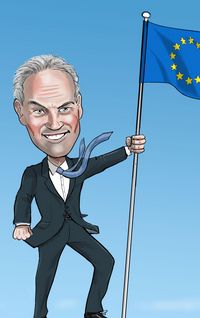(Not) firing on all cylinders
Lucid Group raced onto the capital markets with speed rarely seen before, going public by merging with a SPAC to begin the year and later funding with a convertible bond to crystallise a premium valuation, despite only fledgling commercial operations. The sequence of deals makes up IFR’s Financing Package of the Year.
![]()
Lucid Group, an EV maker steeped in technology, turned heads in February when it announced plans to go public via a SPAC merger, seizing upon a heated market to begin the process of raising US$6.6bn of equity.
In addition to US$2.1bn of SPAC IPO funding, none of which was redeemed, Lucid was able to secure US$2.5bn of PIPE funding at a premium valuation to the SPAC, the first time that had ever happened. The PIPE entailed the placement of 167.7m shares at US$15 each, above the US$10 SPAC IPO price and the high end of a US$13–$15 marketed range.
At the US$15 PIPE price, the merger valued Lucid at US$24bn, the highest for a SPAC merger at the time and second largest since.
Citigroup, which advised Lucid on the merger, and Bank of America, the SPAC adviser, were placement agents on the PIPE and Guggenheim Securities was capital markets adviser.
“Lucid helped illuminate value for EV makers and mobility,” said Douglas Adams, co-head of global ECM at Citigroup. “Its success paved the way for others.”
The banks hashed out final terms of the PIPE investment over a weekend in February to announce on a Monday, after an extensive confidential marketing process. Saudi Arabia sovereign wealth fund Public Investment Fund, Lucid’s largest shareholder, anchored the PIPE atop investments from Fidelity, Franklin Templeton and Neuberger Berman.
Churchill Capital IV, the Lucid SPAC host headed by former Citigroup banker Michael Klein, agreed to an 18-month lockup on its founder shares, allowing it to sell one-third in equal instalments at post-merger share prices above US$20, US$25 and US$30. M Klein, Klein’s firm, also agreed to lend Lucid US$1.5bn for working capital until the deal closed in July.
Churchill shares tanked 38.6% on the deal announcement to US$35.21, reflecting hyped expectations on leaks a deal was in the works but still valuing Lucid at US$56bn. That puts it in the league of traditional car companies Ford Motor (US$49bn) and General Motors (US$85bn).
The merger gave Lucid US$4.6bn of cash and left existing shareholders, led by PIF, which gained majority control after investing US$1bn in 2019, with a 73.5% stake, the SPAC shareholders (including Klein) 16.1% ownership, and PIPE investors 10.4%.
At the time of the merger agreement, Lucid only had reservations for 7,500 cars, a figure that would grow to 13,000 by September, ahead of first deliveries in October.
Lucid, which is run by CEO Peter Rawlinson, projected first full-year deliveries in 2022 of 20,000 cars, rising to 49,000 in 2023, and 135,000 by 2025, when it expects to break even on a free cashflow basis.
The company’s premium EV sedan, the Lucid Air, is core to that growth. Lucid Air boasts a 500 mile-plus range and the ability to recharge for 300 miles in 20 minutes, both industry-leading metrics derived from battery technologies honed as a supplier to the Formula E race circuit.
Lucid Air, which Motor Trend awarded its 2022 car of the year, comes in four models, ranging from US$69,000 to US$161,500, and uses the same powertrain technologies that will be used in its Lucid Gravity SUV, planned for 2023, and mass-market cars beginning in 2025.
This is the same "crawl, walk, run" strategy employed by Tesla.
And much like Tesla, Lucid plugged its path to profitability with US$2bn raised in December from the sale of a convertible bond underpinned by a US$65bn equity valuation.
The US$1.75bn five-year CB priced at a 1.25% coupon and 50% conversion premium, the wide end of 0.75%–1.25% and 50%–55% price talk marketed for one day, with the subsequent exercise of the full 15% greenshoe bumping the funding to just above US$2bn.
Citigroup and Bank of America were joint bookrunners on the CB, which was structured as a green CB, the largest ever. The CB represented a distinct pool of investors that allowed for nearly two-thirds of the deal to be allocated to new investors.
Just days after the CB pricing, Lucid was added to the Nasdaq 100 index, a recognition of the largest, most liquid stocks on the exchange.
Lucid was just one of nine EV makers/EV battery companies that went public via US-listed SPAC mergers in 2021. None were as successful at onboarding capital as fast, from as many markets and as many investors, providing it sufficient charge to endure for the long term.
To see the digital version of this report, please click here
To purchase printed copies or a PDF of this report, please email leonie.welss@lseg.com


